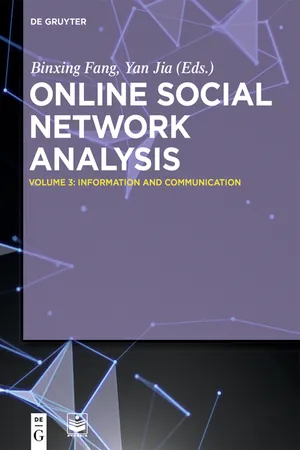
This is a test
- 180 pages
- English
- ePUB (mobile friendly)
- Available on iOS & Android
eBook - ePub
Information and Communication
Book details
Book preview
Table of contents
Citations
About This Book
The three volume set provides a systematic overview of theories and technique on social network analysis. Volume 3 of the set mainly focuses on the propagation models and evolution rules of information. Information retrieval and dissemination, topic discovery and evolution, algorithms of influence maximization are discussed in detail. It is an essential reference for scientist and professionals in computer science.
Frequently asked questions
At the moment all of our mobile-responsive ePub books are available to download via the app. Most of our PDFs are also available to download and we're working on making the final remaining ones downloadable now. Learn more here.
Both plans give you full access to the library and all of Perlego’s features. The only differences are the price and subscription period: With the annual plan you’ll save around 30% compared to 12 months on the monthly plan.
We are an online textbook subscription service, where you can get access to an entire online library for less than the price of a single book per month. With over 1 million books across 1000+ topics, we’ve got you covered! Learn more here.
Look out for the read-aloud symbol on your next book to see if you can listen to it. The read-aloud tool reads text aloud for you, highlighting the text as it is being read. You can pause it, speed it up and slow it down. Learn more here.
Yes, you can access Information and Communication by Binxing Fang, Yan Jia, Binxing Fang, Yan Jia in PDF and/or ePUB format, as well as other popular books in Computer Science & Human-Computer Interaction. We have over one million books available in our catalogue for you to explore.
Information
Information retrieval (IR) is a process of retrieving information, which satisfies users’ need, from massive unstructured datasets (such as natural language texts). IR is an important tool that helps users to rapidly and effectively derive useful information from massive data. With the drastic increase in the size of data and the increasingly growing user needs in search services, IR has evolved from a tool that was only designed for libraries into a network service indispensable in life, work, and study. In addition to the search systems represented by the popular Google search engine, some other common forms of IR systems include classification systems, recommendation systems, and Q&A systems.
With the rapid popularization and continual development of social networking services (SNS), IR not only has new resources and opportunities but is also confronted by new problems and challenges. Acquiring information from emerging resources such as social networks has gradually drawn attention from both industry and academics. Compared with the traditional webpages, social network texts have different characteristics, such as the limit of text length, special expression form (such as Hashtag1 in microblogs), and existence of social relations between authors. These differences make it inappropriate to directly apply traditional IR technologies to an SNS environment. Social network-oriented IR technology still faces many problems and difficulties, and it is of great academic significance and application value to conduct research in this field.
This chapter mainly introduces IR for social networks, and aims to present the challenges faced by IR technology in its applications to new resources of social networks, and also introduces some possible solutions to these problems. Concretely, three most representative IR applications – search, classification, and recommendation are discussed in this chapter. This chapter is arranged as follows: Section 1.1 is the Introduction, which introduces the relevant concepts commonly used throughout the chapter, along with the challenges facing social network-oriented IR technology; Sections 1.2, 1.3, and 1.4, respectively, introduce the basic methods for content search, content classification, and recommendation in social networks, and the status quo of researches in these areas; Section 1.5 provides the summary of this chapter and future prospects. In Sections 1.2 and 1.3, relevant researches are introduced based on microblog data – one of the most representative SNSs, while Section 1.4 focusses on social networks developed from traditional e-commerce websites carrying social networking information, where commodities are recommended by integrating such online social networking information.
1.1 Introduction
IR is a process of retrieving information (generally documents), which satisfies users’ need for information, from massive unstructured datasets (generally texts that are mostly stored in computers) [1].
Unstructured data refers to data without obvious structural markers which differs from structured traditional databases. Natural language texts are the most common unstructured data. User information need refers to an information theme that the user wants to find, while a query is usually a piece of text that the user submits to the retrieval system representing his information need or an object in any other form (such as one or several keywords in the text search engine or sample images in the image search engine).
The dataset being retrieved refers to a corpus or a collection. Each record in a collection...
Table of contents
- Title Page
- Copyright
- Contents
- Preface: Information and Diffusion
- 1 Information retrieval in social networks
- 2 The rules of information diffusion in social networks
- 3 Topic discovery and evolution
- 4 Algorithms of influence maximization
- Index